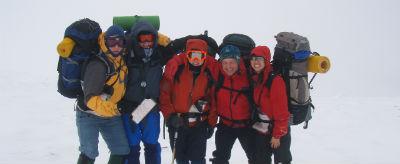Cairngorm Winter Hill-Walking
The Winter in the Mountains course covers fundamental winter walking skills (e.g. using axe and crampons), building on existing skills and developing new skills.

The aim of this course is to allow students to experience the major differences between summer and winter travel in the mountains - especially in terms of weather, navigation, equipment, physical fitness, underfoot conditions and other relevant safety aspects of moving over steep, potentially dangerous ground.
Throughout the week there is a strong emphasis on the importance of accurate navigation, and participants will practice map interpretation, walking on a bearing, pacing, timing and relocation techniques. Snow-pack analyses help us to determine the risk of avalanche and develop safe travel routes. We will also look at weather forecasting and the implications of weather on winter mountaineering
All of this takes part in a spectacular landscape characterised by the effects of glaciation. Ten thousand years ago glaciers retreated and left behind deep glacial U-shaped valleys including the one in which Loch Avon is located. The trained eye can also find other glaciated evidence including moraines, striations and erratics, as well as the associated soil movement known as solifluction.
We are likely to see species associated with the winter landscape, including birds such as ptarmigan which are found only above 2000 feet, and visiting migrants such as the snow bunting and the white mountain hare. Sub-arctic vegetation includes moss campion, alpine cinquefoil and yellow mountain saxifrage.

